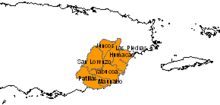Eleutherodactylus cooki
| Puerto Rican rock frog | |
|---|---|
 |
|
| Female Puerto Rican rock frog | |
| Scientific classification | |
| Kingdom: | Animalia |
| Phylum: | Chordata |
| Class: | Amphibia |
| Order: | Anura |
| Family: | Eleutherodactylidae |
| Genus: | Eleutherodactylus |
| Subgenus: | Eleutherodactylus |
| Species: | E. cooki |
| Binomial name | |
|
Eleutherodactylus cooki Grant, 1932 |
|
 |
|
| Known habitat area, east Puerto Rico | |
|
|
|
|
The Puerto Rican rock frog, Eleutherodactylus cooki, also known as the Puerto Rican cave-dwelling frog or rock coqui, and locally as coquí guajón, or guajón for brevity, is a threatened frog species from the coqui genus. This unique species of tropical frogs dwells primarily in crevices and grottos in the Cuchilla de Panduras mountain range in southeastern Puerto Rico. The native name guajón is derived from its habitat, guajonales, which are caves formed by rock formations between huge stones. Despite being the state animal and considered emblematic of the region, of the 17 species of coquí, three are believed to be extinct and the rest are rare and declining in numbers. The Puerto Rican rock frog is extremely restricted in geographical distribution. The frog is threatened due to deforestation, agricultural, rural, and industrial development, and the associated infrastructure. It is sometimes called the “demon of Puerto Rico" (demonio de Puerto Rico in Spanish) because of its eerie call and phantom-like appearance. The species was first described by American herpetologist, Chapman Grant in 1932.
Females are slightly larger than males, reaching a mean size of 2.01 in (51 mm) in length, whereas the males reach about 1.7 in. They are solid brown with whitish under parts, and large, white-rimmed eyes, giving them a phantom-like appearance. Breeding males and some females may have yellow throats and abdomens, and it is the only Eleutherodactylus species which exhibits sexual dimorphism in color and size. The species is characterized by large truncated discs under the frogs’ feet, and a peculiar, melodious, low voice completely different from any other coquí in Puerto Rico.
The Puerto Rican rock frog is a petricolous (i.e., inhabits rocks) frog species endemic to the southeastern part of Puerto Rico. This species is one of 16 species of the genus Eleutherodactylus, commonly known as “coquíes” that inhabit the island. The phylogenetics relationships of frogs were established from the West Indies, using morphological characteristics belonging to Eleutherodactylus. Three groups or classes were recognized for the West Indies: E. inoptatus, E. ricordii, and E. unistrigatus. This species is a member of the West Indies subset of the E. unistrigatus group. The Puerto Rican rock frog is the second-largest species of Eleutherodactylus in Puerto Rico.
...
Wikipedia

